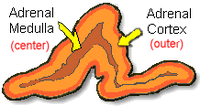
Adrenal gland: cortisol or cortisone is produced by the outer, or cortex (shown at right) area.
Addison's disease, also known as hypoadrenocorticism, is a chronic condition in which the adrenal glands[1] produce insufficient cortisol. It is the opposite of Cushing's disease.
The adrenal glands produce two types of hormones; we're most familiar with the glucocortoid ones, such as cortisone. Cortisol and other hormonal levels rise during anger or fear, stress or injury. The term "getting one's adrenalin going" in response to these situations applies to the natural response a healthy body has to them. Those with faulty adrenal glands don't produce enough cortisol to allow the body to respond properly.
The other adrenal hormones, known as mineralcorticoids, are what keeps the system in balance regarding proper amounts of salt, potassium[2], and water in the body. Imbalances of these keys to life can have grave consequences also[3].
As in diabetes, the problem is not enough--not enough of the hormones the adrenal glands produce necessary for proper bodily function. Also like diabetes, Addison's is an endocrine disease, and its sufferers are at risk of developing neuropathy.
Symptoms[]
The symptoms range from poor appetite, lethargy. weight loss, and can include shaking and/or shivering, polyuria[4], hypoglycemia[5] diarrhea and vomiting. They are not always specific--many are similar to those of other diseases[6].
Untreated Addison's disease, like untreated diabetes, can be fatal. It is also like diabetes in the respect that the disease is often well-advanced by the time symptoms occur.
It is possible to see no symptoms of Addison's disease until 90% of the adrenal cortex is no longer functioning[7].
|
Those with untreated Addison's disease are at risk for what's known as an Addisonian crisis, where, possibly under any stressful situation, they go into shock because of the lack of these hormones to regulate the body. This is a life-threatening situation. The diagnosis of about 35% of all canine Addison's patients begins when they are brought to the hospital or clinic in Addisonian crisis. In crisis, the shock symptoms mimic those of "classic" shock; Addisonian shock also includes a slow heart rate due to high potassium blood levels[8]. | ||
Causes[]
The cause(s) of Addison's are not always clear--most are attributed to an overactive immune system or are simply idiopathic--no cause able to be found.
Addison's can result when there has been long-term steroid therapy and the medication is suddenly stopped[9].
Use of steroids means that the adrenal glands do not function fully during the course of the medication. The body senses the levels of the exogenous steroids in the system and therefore does not signal for additional production of it.
During this time, the adrenal glands go into a type of "hibernation" because the steroid medication is literally doing their work for them. In pets and people, the usual protocol for stopping steroid medications is not to eliminate them suddenly, but to withdraw from them gradually in a "tapering off" process. Doses become less and less frequent prior to the planned cessation of the medication.
This tells the body to signal the "hibernating" adrenal glands that it's time to go back to producing adrenal hormones. Simply put, the "sleeping" adrenal glands are not able to be "awakened" in cases like this, and the body will need to have its adrenal hormones replaced by medication.
There are times when the adrenal glands must either be removed or made to stop functioning with medication. This is sometimes neccessary in the treatment of Cushing's disease, which occurs when the adrenal glands are overactive. The loss of the adrenal glands means that the patient now has Addison's disease and must take medication to replace the hormones the adrenal glands formerly supplied[10].
Treatment[]
Diagnosis is through testing. Treatment is by replacing or augmenting the insufficient or absent hormones[11]. Addison's disease patients will need this treatment for the rest of their lives and can lead normal ones, as long as they are given proper treatment for their deficiency[12].
Dogs[13] with diagnosed and treated diabetes but undiagnosed/untreated Addison's disease may have reduced insulin needs.
Further Reading[]
- Feline Addison's Disease-University of Illinois-Veterinary Clinical medicine-Page 2
- Addison's Disease in Cats-Petplace.com
- Diagnosis and Treatment of Canine Addison's--Treating Addisonian Crisis
- New Hope Animal Hospital offers more information on Canine Addison's Disease and its treatment.
- Introduction to Canine Hypoadrenocorticism (Addison's Disease)-Axiom Vet Laboratories UK
- Emergency Therapy for Dogs-Acute Addisonian (Hypoadrenocorticism) Crisis-Axiom Vet Labs UK
- K9 Addisons Mailing List-Help & Support
- Addison's Disease: Helpful Links Page
- Addison's Disease
- Addisondogs.com-Support and Discussion of Canine Addison's Disease
- Use of Basal Plasma Concentrations to Rule Out a Diagnosis of Hypoadrenocorticism in Dogs-ACVIM 2006-Page 25, Abstract #68
- Glucocortoid Deficient Hypoadrenocortisism More Prevalent than Previously Believed-ACVIM 2006-Page 25, Abstract #69
- Hypoadrenocorticism in 98 Dogs-ACVIM 2006-Page 79, Abstract #229
- Recognizing & Treating Addison's Disease-WSAVA 2003
- Gastrointestinal Signs in Endocrine Disorders of Cats & Dogs-Provet UK
- Addison's Disease-Hypoadrenocorticism-Drs. Foster & Smith Pet Education Library
- Acute Adrenocortical Insufficiency (Addison's Crisis) WSAVA 2005
- MarVista Vet
- Low Sodium: Potassium Ratios in Dogs and Cats-WSAVA 2003
References[]
- ↑ Wikipedia:Adrenal glands
- ↑ Pet Education.com-Drs. Foster & Smith-Potassium Toxicity & Addison's Disease
- ↑ Endocrinology-an Integrated Approach-Aldosterone
- ↑ Diabetes Mellitus-petplace.com
- ↑ Hypoglycemia in Dogs-Petplace.com
- ↑ Addison's Disease Symptoms
- ↑ Addison's Disease-Adrenal Cortex Disfunction & Symptoms
- ↑ Addisonian Shock
- ↑ Cessation of Steroid Treatment/Addison's Disease
- ↑ OSU Endocrinology Symposium 2006-Hypoadrenocorticism (Addison's Disease) in Dogs-Page 20
- ↑ About Pericorten-V-Treatment for Canine Addison's Disease-Novartis Animal Health
- ↑ Southpaws.com-Addison's Disease
- ↑ Canine Diabetes & Addison's Disease